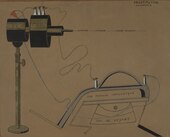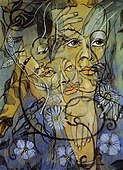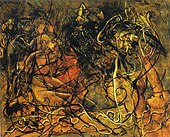
Francis Picabia
Francis Picabia (French: [fʁɑ̃sis pikabja]: born Francis-Marie Martinez de Picabia; 22 January 1879 – 30 November 1953) was a French avant-garde painter, writer, filmmaker, magazine publisher, poet, and typographist closely associated with Dada.[1]
Francis Picabia
22 January 1879
30 November 1953 (aged 74)
Amorous Parade
When considering the many styles that Picabia painted in, observers have described his career as "shape-shifting"[2] or "kaleidoscopic".[3] After experimenting with Impressionism and Pointillism, Picabia became associated with Cubism. His highly abstract planar compositions were colourful and rich in contrasts. He was one of the early major figures of the Dada movement in the United States and in France before denouncing it in 1921.[3] He was later briefly associated with Surrealism, but would soon turn his back on the art establishment.[4]
Personal life[edit]
He was married in 1909 to Gabrièle Buffet-Picabia, a French art critic and writer affiliated with Dadaism and later an organizer of the French resistance. They had four children. They divorced in 1930. Their tumultuous union is re-imagined by great-granddaughter Anne Berest in The Postcard, a semi-autobiographical French novel published in 2021.[19]
Legacy[edit]
Public collections holding works by Picabia include the Museum of Modern Art and Solomon R. Guggenheim Museum in New York; the Philadelphia Museum of Art; the Art Institute of Chicago; the Tate Gallery, London and the Musée National d'Art Moderne, Paris.
In the mid-1980s two of Picabia's Dada writings, Who Knows and Yes No were published in English by Hanuman Books and in 2007 MIT Press published a large book of his poetry and other writings in English called I Am a Beautiful Monster: Poetry, Prose, and Provocation that was translated by Marc Lowenthal.
A major retrospective of Picabia's work in the United States was held in 2016 at Kunsthaus Zürich and then from 2016 to 2017 at the Museum of Modern Art, New York.[20] The retrospective was widely discussed by international art critics such as Philippe Dagen from Le Monde.[21]
Among the artists influenced by Picabia's work are the American artists David Salle and Julian Schnabel, the German artist Sigmar Polke, and the Italian artist Francesco Clemente.[22][23][24][25] In 1996, French artist Jean-Jacques Lebel initiated and co-curated the exhibition Picabia, Dalmau 1922 (with reference to Picabia's solo exhibition at Galeries Dalmau in 1922) shown at Fundació Antoni Tàpies in Barcelona and the Musée National d'Art Moderne, Centre Pompidou. In 2002, the artists Peter Fischli & David Weiss installed Suzanne Pagé's retrospective devoted to Picabia at the musée d'art moderne de la ville de Paris (MAMVP).
In 2003, a Picabia painting once owned by André Breton sold for US$1.6 million.[26] Picabia's Volucelle II (c. 1922) sold for
US$8,789,000 at Sotheby's in 2013, then the highest price for one of the artist's works.[27][28] A new record was set in 2022 with the sale of Pavonia at Sotheby's for US$11 million.[27]






















